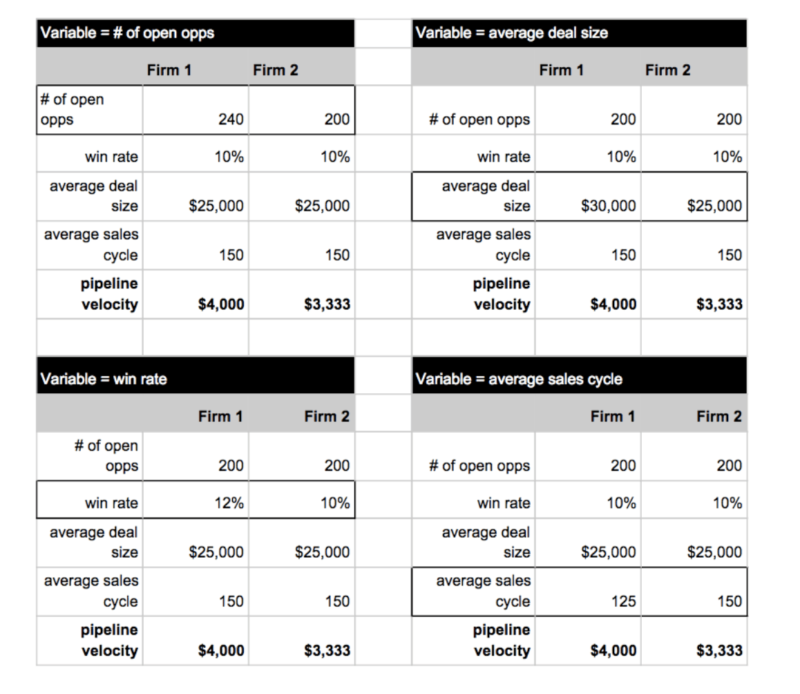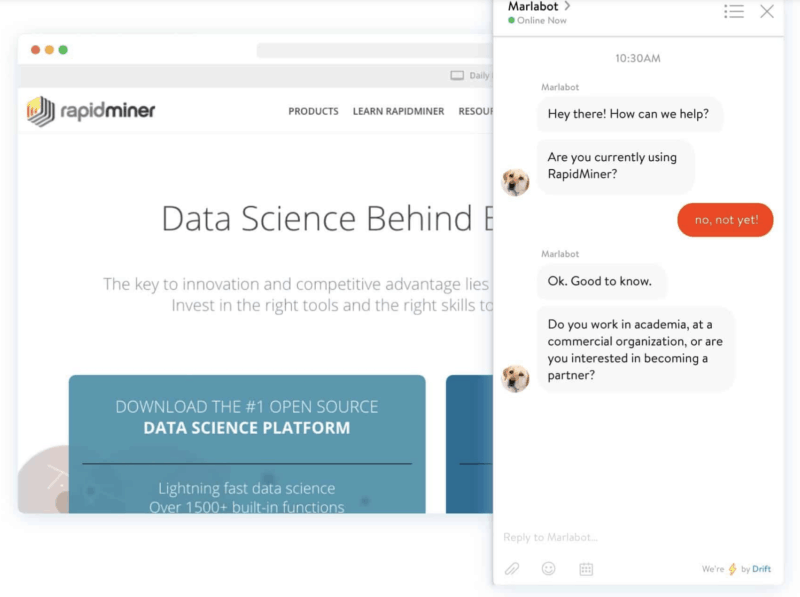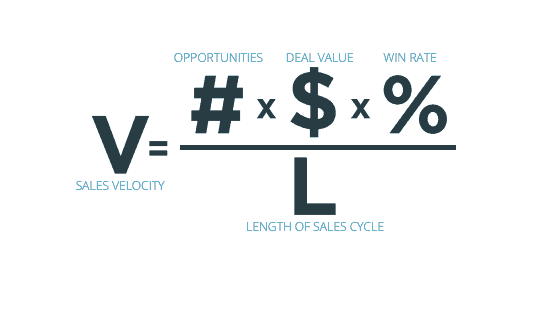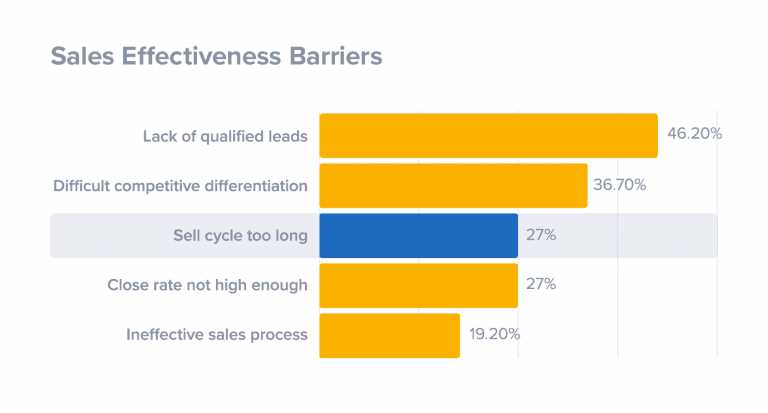
It doesn’t matter if you’re a start-up or a B2B corporate powerhouse – you probably have sales goals to meet, deals in progress, and target accounts your reps are dying to lock down.
And, we’re willing to bet that meeting those goals means closing more deals in a shorter amount of time.
To do this, you’ll need to increase your sales velocity. If you’re unfamiliar with the term, sales velocity is a basic calculation that tells you how much revenue you can expect to bring in over a certain amount of time.
Sales velocity is something of a diagnostic tool – a means for breaking down each variable that has an impact on the overall results. Done right, this formula allows teams to identify the source of a bottleneck, problems with their demand generation process, or inefficiencies in your strategy.
Many people claim that sales velocity is the single best metric for measuring rep performance–but the reality is a bit more complicated than that. At the end of the day, sales velocity is a prediction – so its efficacy hinges on the quality of your data, market segmentation, and more.
Below, we’ll talk more about the four levers powering your pipeline and how you can “pull” them to accelerate your velocity.
What is Sales Velocity?
The concept of sales velocity isn’t all that different than velocity, in that it measures the rate at which a lead becomes a prospect, then a customer.
Pipeline velocity is composed of four key components:
- Number of Qualified Leads – A steady pipeline of qualified leads is the basis of any sales strategy. Looking at the number of opportunities in the pipeline will give you a sense of whether your team is on track to hit quotas or if you need to amp up the prospecting efforts.
- Average Deal Size – This number is represented by the dollar amount generated by a closed deal. Obviously, the bigger the deal size, the better, but teams need to remember that it’s not all about chasing the biggest fish in the game. Going after the biggest contracts means that you’ll spend more time closing each deal – you’re dealing with more decision makers, thus slowing down the average time to close.
- Win Rate – Win rate represents the number of qualified leads that end up as paying customers. Looking closely at this number will help you identify issues with your qualification process and will give you a sense of your team’s ability to close a deal.
- Average Conversion Time – our average conversion time is the number of days that it takes for sales teams to take a new lead and turn it into a closed deal – signed contract and all. This metric depends on several factors – overall efficiency, pricing, number of decision makers, and so on.
Why Top Sales Leaders Are Doubling Down On Conversational Marketing & Sales for 2019
How to Calculate Sales Velocity
Google anything about sales velocity and you’ll see something like this graphic below.
Each of the four variables we’ve outlined above are closely related – and function like triggers you can pull to increase your sales velocity.
They allow you to pinpoint the areas most likely to impact the bottom line – and tracking these efforts in your CRM gives you the ability to tighten up your sales strategy for the long term.
The top half of the equation shows you how much revenue you can expect to bring in. When you divide that number by the length of your sales cycle, you’ll get an estimate of how quickly you can expect to bring that money in.
The higher the velocity, the faster you’re making money. We like this example here, as it illustrates just how much of a difference focusing in on one area, be it win rate or deal size, can make.

Here are some ways to boost your velocity:
Bring in More Qualified Leads
The most obvious way to give your pipeline a boost is to add more fuel to the engine. See, the more leads you can add to the pipeline, the more chances you’ll have to turn leads into opportunities, and later, close the deal.
Sales teams that aren’t closing a whole lot of deals may want to start here, with their lead generation strategy. One approach might be to build out your lead generation strategy–increasing PPC budget, investing more time into social media activities or content marketing–you know the drill.
Of course, one of the pitfalls of increasing the number of leads in your pipeline is making sure that you don’t sacrifice quality in the service of quantity.
Get Conversational
Let’s say your marketing team is killing it with their lead gen efforts – they’ve put together a multi-touch brand awareness campaign on social, Google Ads, and beyond.
While these ads might be reaching the right audience, not everyone who clicks through is going to be a match for your company’s offering.
Adding a chatbot to your landing page or a high-intent page, as opposed to a form, can help you make sure you focus in on collecting high-quality leads. Take, for example, one of our customers, SalesRabbit. They’ve found that bots helped them generate 50% more qualified leads than when they were using forms, and book 40% more demos.
Update Your Lead Gen Efforts
Unfortunately, traditional lead generation methods alone don’t always give reps a pipeline full of qualified leads with money to spend.
Lead capture forms slow sales teams down, and often, frustrate qualified leads who leave your website without leaving their contact information.
Free Guide: Revenue Success Secrets from Top Sales Pros
By adding Drift’s LeadBot to your website, you can open up a direct line for leads, routing the best leads to the right rep by asking discovery questions to weed out the people who aren’t a great fit.
You can also use Drift Intel, a feature that uses IP-tracking technology to let you know when high-quality leads are on your site, even if they’re browsing anonymously.
Increase Your Average Deal Size
Increasing your deal size is a bit tricky – and your ability to do this depends on a few things: can you cross-sell with efficiency? Can you connect price to value?
It’s no big secret that bigger deals tend to take longer to close, so much of reducing the sales cycle boils down to time management.
You’ll want to make sure you segment your various customer groups so that you can identify (then optimize) the average time to close by company size, type, and so on. From there, spread out the deal load so you’ve got a mix of fast-closing smaller deals and a few whales.
Better yet, you may be able to close small deals in real-time by adding chatbot software to your website, freeing up time to work the large deals that require custom solutions and involve several decision-makers.
Develop an ABM Strategy
Account-based marketing, or ABM, is a team effort, where sales reps work together to sell to an organization, not an individual. Drift’s ABM software connects teams directly with target accounts, in real-time, allowing you to qualify VIP accounts on the spot, then track your performance through our straightforward reporting tools.
Source
Shorten the Sales Cycle
According to data from CSO Insights, 27% of sales reps say that a long sales cycle is their biggest barrier to an effective sales process.
For many organizations, deal-stalling bottlenecks occur somewhere between prospecting and follow-ups. Think about how much time you’re spending on manual phone calls and follow-up emails.
If shortening the sales cycle is your goal, then you’ll want to implement some new solutions that give leads the information needed to close right then and there.
Respond to Inquiries in Real-Time
If you have a chatbot on your website, you’ll always have “someone” manning the site, asking qualifying questions to determine whether a visitor is a good fit for your brand – or if they’re not in the right place. For example, our chatbot asks visitors if they’re looking for sales, marketing, or support.
We don’t offer a support-focused chatbot and let customers know this upfront. This way, reps won’t receive an influx of inquiries from people looking for a support bot and can focus their energy answering questions from people seeking to level up their marketing and sales strategy with chatbots.
Book Meetings on the Spot
Drift offers a few features that bring more efficiency to the sales cycle. Drift Meetings allows teams to show personalized “book a meeting” CTAs to your target accounts, so you can instantly book meetings rather than relying on forms and back and forth emails to book sales.
Use Content to Nurture
One of the things we like to talk about here at Drift is this idea of helping versus selling.
As such, it’s essential to understand that presenting the right information at the right time is the key to closing more deals.
Take to your data sets and look for the questions and objections that come up over and over. As you map out these FAQs, work them into your content strategy–from email and chat messages to knowledge base entries and blog post.
The idea is to shape the conversation so that you present your solution as the best possible option.
Boost Conversions
Boosting conversions is easier said than done. Part of it comes down to attracting better leads, but the rest is all about timing–presenting the right message at the right time.
Revisit Your Lead Qualification Process
Seasoned sales pros already know that the following information is essential when it comes to qualifying leads:
- Find out what the prospect needs
- Confirm your solution can solve their problem
- Find out the prospect’s budget
- Identify prospect’s influence–are they a decision-maker or is there someone better you can connect with?
Where things get tricky is, today’s customers do much of their purchasing research on their own, well before reaching out to a sales rep.
As such, you’ll need to use tools like an on-site chatbot to engage visitors on the scene – learning exactly what they need right then and there. Here’s an example of how one of our clients, Rapid Miner is using Drift to learn more about incoming leads (which, no big deal, has netted them 4,000 Leads and $1M in Pipeline).

Watch Out For Leaks in the Pipeline
Look at your pipeline and keep an eye out for leaks – or places in the sales funnel where people are dropping out.
Is there a particular area where reps are stalling? What can you do to deliver a better experience at that stage?
Once you’ve identified the source of the problem – dig deep into the data you have. What objections keep coming up during the consideration stage? Are people searching for information they can’t find? Is there some confusion about the offer?
Tie Everything Back to Revenue
To keep your eye on the prize, you’ll need to measure your results long-term. Our Revenue Reporting feature allows you to review all of the conversations you’re having through Drift as well as demos booked, meetings, scheduled, and how these elements impact sales numbers.
When Sales Velocity Becomes “Silent Killer”
Okay, fine, silent killer might sound a bit extreme, but there are some things that you need to know before you build an entire sales strategy around velocity calculations.
Brands may be better off focusing on how they can work together to land big accounts, where automation can help reps speed up the sales cycle, and how access to more customer data than ever allows teams to level up their lead gen.
If you look at this chart, you’ll see these four reps all have roughly the same velocity calculation, but different means of hitting that endpoint. Sales managers and executives should keep this in mind as they review pipeline reports with individual reps.
While all of these fictional reps kind of end up in the same place, you might not be getting the most out of your reps if Sarah only converts 42% and seems to be playing a numbers game, whereas Jack is moving a bit slower, but has a 70% close rate. Sales leaders might bring in Sarah’s efficiency, along with Jack’s effective sales scripts. Jessica’s strength lies in landing higher value deals.
As with anything related to sales and marketing these days, segmentation should be central to just about everything you do. This means setting sales goals based on the variation that exists within your prospect pool, as well as hyper-targeted ABM accounts.
Not every account is one where you would use account-based marketing, but nailing your sales strategy is about providing personalized, data-driven solutions to your audience. Ideally, calculating your sales velocity will give you a benchmark you can use to inform your later outreach efforts.
That said, this can only work if you keep your definitions and variables consistent. For example, when does a lead become an opportunity? What does a quality lead look like? Define all criteria and stick with it for the long haul.
Wrapping Up
While high-velocity sales aren’t the only thing sales leaders should focus on, this formula offers sales pros an easy way to understand the factors that make or break their ability to close the deal and hit those quotas.
Sales velocity puts the emphasis on balance. Build your sales strategy around quality leads, time management, and personalization, and chances are, you’ll have pushed the right levers.






